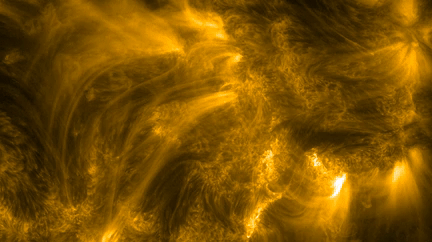The European Solar Orbiter spacecraft took the highest-resolution video ever of the upper layer of the sun’s atmosphere, the corona.
The spacecraft, launched in 2020, took the image sequence during its recent close approach to the sun, or perihelion, on Oct. 13. The video sequence, taken with Solar Orbiter‘s Extreme Ultraviolet Imager (EUI), reveals the corona in a tranquil, almost motionless, state. The apparent calm is quite surprising because the sun’s activity has recently been picking up due to the star‘s 11-year cycle of activity.
The corona is the puzzling outermost region of the sun’s atmosphere that extends millions of miles or kilometers into outer space. The corona is extremely hot, over 1.8 million degrees Fahrenheit (1 million degrees Celsius), much hotter than the sun’s surface, which has only about 10,000 F (6,000 C). This region is the source of coronal mass ejections, bursts of magnetized plasma that can interfere with Earth’s magnetic field and trigger geomagnetic storms, causing auroras, power blackouts and satellite glitches.
Related: Mysterious region of the sun shines in new photo from world’s largest solar telescope
Solar Orbiter took the video sequence when it was 27 million miles (43 million km) from the sun’s surface, about 29% of the Earth-sun distance, which is closer than the orbit of the solar system‘s innermost planet, Mercury.
Each pixel in the video covers an area 65 miles wide (105 km), which means that 17 Earths would fit across the image, according to a statement (opens in new tab) from the European Space Agency (ESA), which manages the mission.
The arches of bright plasma visible in the sequence are held in place by powerful magnetic loops that emanate from the sun’s interior, ESA added.
Solar Orbiter is one of two spacecraft currently exploring the sun up close. NASA’s Parker Solar Probe makes deeper dives toward the star’s surface, but Solar Orbiter takes images from a closer viewpoint than any spacecraft before. The environment in the region where Parker Solar Probe travels, a few million miles above the sun’s surface, is too hot for an imaging instrument to survive.
Together, the two spacecraft are helping scientists understand the sun’s behavior. Although the sun is our closest star, there is still a lot about it that puzzles scientists, like why the corona is so hot nor how exactly the sun’s 11-year activity cycle works.
Follow Tereza Pultarova on Twitter @TerezaPultarova (opens in new tab). Follow us on Twitter @Spacedotcom (opens in new tab) and on Facebook (opens in new tab).


